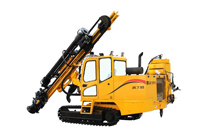Analysis of Inadequacy of Rotary Drilling Rigs and Misunderstandings in Use
Disadvantages: Rotary drilling rigs are also constrained by various conditions such as the geological conditions of the stratum being constructed, the machine's own factors, and man-made factors such as the operator. There are some currently difficult situations to deal with, which are mainly not suitable for hard formations. In the initial stage of the use of rotary drilling rigs, blind superstition or lack of understanding of rotary drilling rigs can easily give people the illusion and cause misunderstanding, which directly affects the use of rotary drilling rigs.
Rotary drilling rigs are also constrained by the geological conditions of the formation. In hard rock formations, dense cobblestones, and solitary rock formations, drilling becomes more difficult. Failure to replace the drill bit is prone to accidents. Although it can be equipped with core drills, impact drills, and grab cone drills for hard rock formations, pebble formations with a particle size of more than 100 mm, and pumice formations with a diameter of more than 200 mm, their actual efficiency and actual effect are similar to those of traditional DTH rock drilling rigs The effect is still not ideal.
Misunderstanding analysis: When using a rotary drilling rig to form a hole, common pile foundation construction accidents such as hole collapse and diameter reduction will occur like other rigs. The reasons for this are subjective and objective reasons. Human factors and defects in the current mechanical equipment design coexist . Rotary drilling rigs have different construction methods and methods depending on the stratum. Without an objective understanding of rotary drilling rigs and a deep understanding of the geological conditions of the formations in the area, it will be difficult to avoid accidents.
Hydraulic Drilling Rig
When encountering collapse-prone formations, high-quality static mud is used for wall formation, and the technical requirements of slow-running and multi-sweep of previous drilling rigs should also be strictly adhered to. We should not just seek to reflect the advantages of the rotary drilling rig's drilling progress and economic benefits, and quench our thirst. Ignore the quality of the mud wall and the number of sweeps, leaving hidden dangers to the formation of the pile foundation and the pile foundation pouring. When the rotary drilling rig passes through the expansive soil layer, it should also strengthen the sweeping to prevent the occurrence of shrinkage.
Strictly control the lifting speed of the bucket during the hole formation process. The drilling speed should be strictly controlled during the drilling rig to avoid excessive drilling scale. If the speed of the hydraulic drilling rig is too high, the mud between the outer wall of the drill bucket and the hole wall will wash the hole wall, and the lower part of the drill bucket will generate a large negative pressure, which will cause the necking and collapse of the hole wall. When the bucket is operating in silt or sub-sandy soil, its lifting speed should be slower. When necessary, for special weak formations, the drilling rig's operation time is limited, and the drilling speed cannot be blindly pursued. After 3 to 4 test piles, determine the best scientific hole formation time, and then guide the normal construction of the rotary drilling rig.
Structural problems of supporting drill bits and other equipment of the rig. When the double-door bottom-open slewing bucket produced by some manufacturers is used, the lifting force of the slewing bucket is significantly increased, forming a piston effect, and it is easy to cause collapse and shrinkage.

评论
发表评论